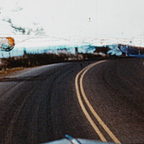Saving an artist’s legacy: Stelarc donates his moving image archive to ACMI for preservation
Internationally renowned Perth-based artist Stelarc recently donated his audiovisual collection of over 1000 hours of footage to ACMI. This remarkable moving image collection comprised of Stelarc’s performance, artwork and project documentation spans four decades of artistic practice and ACMI’s Collections team is thrilled to be working closely with him to preserve such a legacy.
Regarded as a pioneering performance artist Stelarc continues to experiment with, theorise and test the limitations of the body and its relationship to technology as seen in his ongoing Ear on Arm project which, true to its title, sees Stelarc modify his body’s architecture with the engineering of a ear-shaped prosthesis to his arm. His moving image archive similarly illuminates his penchant for the extreme and provides invaluable insight into to his oeuvre.
Upon receiving the collection we discovered an array of content exisiting on over 400 physical carriers, most of which had not been digitised or if they had, it was sporadic and numerous hard drives revealed numerous codecs to consider. The predominantly analogue carriers range from commonly produced formats such as u-matic and VHS tapes to rarer examples — M60L, M20S and 3.5" SyQuest cartridges for instance.
Magnetic media formats are particularly vulnerable to material deterioration, environmental catalysts and age can cause soft binder or sticky shed syndrome — the deterioration of the tape’s binder and shedding from its substrate. Such shedding can flake and clog the heads within playback machinery inevitably causing picture image issues such as signal loss and image drop-out as can be seen in the sequential frames taken from the Master u-matic tape here:
In some cases cleaning and even tape baking provide an opportunity to stabilise, treat and digitise such carriers. Soft binder syndrome is not only a concern for each tape, but also for the play back machinery which is becoming increasingly hard to keep operational and or even find (we’re still searching for equipment for the M60L, M20S formats).
Efforts to preserve a diverse collection like this (and others) are not possible without collaboration, planning and a robust conservation framework.
Digitisation, migration and documentation have been key tools in beginning the preservation work for this collection. These combined with open source software applications like QC tools, a transcode platform developed via Python script by our talented in-house digital team (soon to be made available via gitHub) make long term preservation possible.
Continued collaboration with Stelarc affords us the opportunity to understand and directly document artistic intent as means to measure against future unwanted change and will eventually enable access to this invaluable research resource for those studying Australian contemporary art.
The documentation process around this preservation project will continue and be made available in future posts as well as all the other exciting collaborative ventures we’re undertaking with artists.
